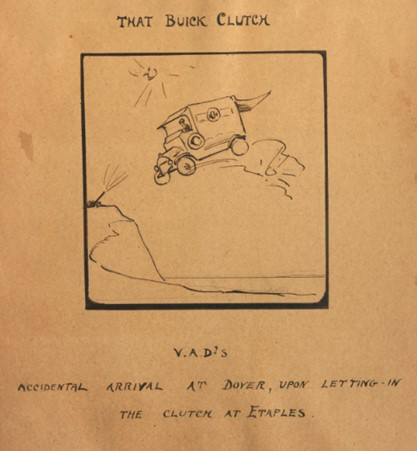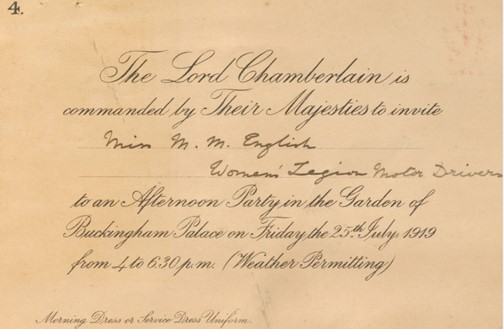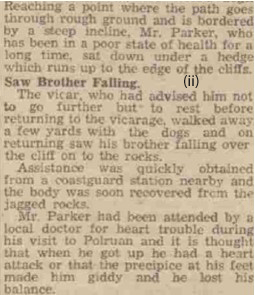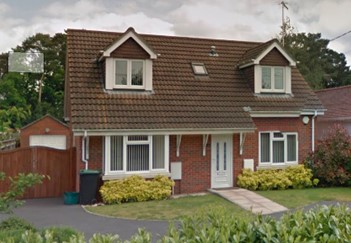Muriel the Ambulance Driver
- Home
- World War I Articles
- Muriel the Ambulance Driver
This article was instigated by the discovery of a pension card, for a Mrs Muriel M. Parker, during the recently completed WFA ‘Big Push’ Project.

Above: the Pension Card for Muriel –Pension cards for women are quite scarce, and the information regarding her maiden name of ‘English’ proved invaluable in establishing her identity.
The Pre War Period
Muriel Mina English was born in Papworth, her birth being registered in the third quarter of 1881, with mother’s maiden name of Young, in the Caxton district, which lies on the borders of Cambridgeshire and Huntingdonshire.
Census and other genealogical records were used to establish that her mother, Emily Mina Young, was born on 19 September 1841 in Singapore, and baptised on 20 February 1842 on Prince of Wales Island, Bengal. She married Muriel’s father, George English, a native of Lewes, Sussex, on 1 August 1861 in Madras.
The 1891 census shows Muriel living with her parents, George and Emily, in The Rectory, in the village of Combe Hay, near Bath. The rectory is now privately owned.

Above: The Old Rectory, Combe Hay Photo: mylondon.news
Muriel was still living at The Rectory at the time of the 1901 census, but her mother had died in 1892, while on the Isle of Wight, aged just 49.
Her father died at the rectory in 1903, and by 1911 Muriel had moved to 2 Stanley Villas, Bath, and was living with her elder sister Gertrude, with her occupation described as ’Private Means’.
The War Years
The medal roll for Muriel indicates that she was awarded the British War and Victory Medals for service in France and Belgium between 24 April 1916 and 25 July 1917, as a section leader in the Voluntary Aid Detachment (V.A.D.), attached to B.R.C.S. & St. John (British Red Cross Society & St John Jerusalem), in the capacity of a section leader.

Above: the Medal Roll
Further details were established from her British Red Cross records, two cards being found. The first card confirms the dates of her overseas service, giving her address in Bath, as shown in the 1911 census. She was thirty three years old, and a chauffeuse, a term in common use for motor ambulance drivers.


Above: the British Red Cross record for Muriel English
A second card shows she was initially engaged in November 1914 as a hospital secretary , serving six months at the Number 1 Red Cross Hospital, Bath. She was then sent to the Metropolitan Asylum Board (MAB), in London, for ambulance training, before being assigned to the Womens Legion (as mentioned on her pension card) as head driver under the R.A.S.C. (Royal Army Service Corps). She also served from June 1915 with the Womens Reserve Ambulance while waiting to be sent abroad.


Above: the second British Red Cross record for Muriel English
Subsequent to her return from France she is known to have served at Aldershot in 1918, and in the summer of 1919 joined a group of ambulance drivers and nurses to tour the battlefields of France and Belgium, witnessing the clean up efforts. This latter information was obtained from the website of the University of Toronto, who hold a collection of some 200 photographs contained in three albums belonging to Muriel.
The entire contents of her albums, purchased by the Thomas Fisher Rare Book Library in 2017, have been digitised and made freely available on Flickr, with no restrictions. They have immense value, particularly as most carry annotations.
The albums cover the hospital in Bath, her training at the Metropolitan Asylum Board and Aldershot, followed by the overseas photographs which centre on her work transferring wounded soldiers from clearing stations to hospitals, as well as the provision of transport for funerals. Her post war tour included Ypres and Arras, and she even travelled as far as Cologne.
A selection of the photographs are shown here.


Above: training for maintenance of ambulances at the MAB yard and at Aldershot.


Above: the team mascot, perched on the bonnet of a Buick ambulance and Muriel’s cartoon about the Buick.
These particular ambulances weren’t the easiest of vehicles to drive, and the notoriously fierce clutch is illustrated in the above cartoon, which reveals Muriel’s sense of humour.
Her ambulance was sponsored by her home city, and evidently had its own identity, although the origin of the name ‘Sidi Deasy’ is not known.

Above: Muriel with ‘Sidi Deasy’



Above: a further three pictures from Muriel’s photograph album – walking wounded, stretcher cases and the use of ambulances as makeshift hearses.
As mentioned above, in 1919, Muriel went on a battlefield tour with a group of ambulance drivers and nurses. The first of the pictures from the tour suggests she had suffered a minor mishap.


A visit to Cologne was also on the agenda, and the requisite leave pass, issued just over a year after the armistice, must surely be a very rare surviving example.

Above: Muriel’s leave pass for her visit to Cologne in November 1919.
A well deserved invitation to a garden party at Buckingham Palace, prior to her battlefield tour, is a suitable way of rounding off the extracts from Muriel’s albums.

Above: Muriel’s invitation to a garden party at Buckingham Palace
The Post War Years
The marriage index at bathbmd.org shows that Muriel Mina English married Arthur William Michael Parker, at Bath Abbey & St. James, in the third quarter of 1924.

Above: Bath Abbey. Photo – bathabbey.org
Muriel’s husband, Arthur William Michael Parker, was baptised on 26July 1874, in the parish of Llantilio Pertholey, near Abergavenny, Monmouthshire. He was the son of Robert Lesley Parker and Amelia Philips, who married in 1865 in Royston ,Hertfordshire.
The family moved to Newton Abbot, where Arthur’s father, who had served as a captain in 15/Hussars, died in 1881, leaving young Arthur without a father at just seven years old. He lived with his mother until her death in 1901. Little more is known about Arthur’s life, apart from the 1911 Census recording him as a boarder, on private means, at the Thurlestone Hotel in Kingsbridge, Devon.
The Parking Ticket
The next time Muriel comes to our attention was in 1932, when she was issued with a summons for a parking offence in Bath. It can be safely assumed that the Military Police were a little less fastidious than the Bath Constabulary when it came to leaving her ambulance unattended, and in far more dangerous circumstances.

Above: the report which appeared in the Bath Chronicle & Weekly Gazette of 16 July 1932.
Loss of her Husband
A somewhat moth eaten 1939 register entry shows Muriel living with her husband Arthur, and her sister Gertrude, at the same address in Limpley Stoke, near Bath. The next discovery was Arthur’s death in 1940, at a rather unusual location, as revealed by his probate record.

The unfortunate circumstances relating to his death in Cornwall were reported as below.




Above: the report on Arthur’s death in the Bath Weekly Chronicle & Herald on 6 April 19140.
This must have been a very distressing occasion for his brother, John Lesley Parker, also born in Abergavenny, to both witness and to have to later recall the event at an inquest.
The next sad event for Muriel appears to have been the death of her sister Gertrude in 1945, while still a resident of Hayes Kop in Limpley Stoke.
Death of Muriel
Muriel lived to the age of 91, her life coming to an end in Dorset in 1973. Her probate entry records her address as 14 Braeside Road, West Moors, Wimborne, Dorset.

Above: a current picture of the property in which Muriel lived.
This was one of many cases of a potentially interesting card leading to the unravelling of a fascinating story. Muriel was a rector’s daughter, brought up near Bath, and who served as an ambulance driver in the Great War, leaving behind a truly remarkable collection of photographs, which depict her training, war service, and a post war tour to the battlefields.
Article contributed by Dr. Alan Hawkins





